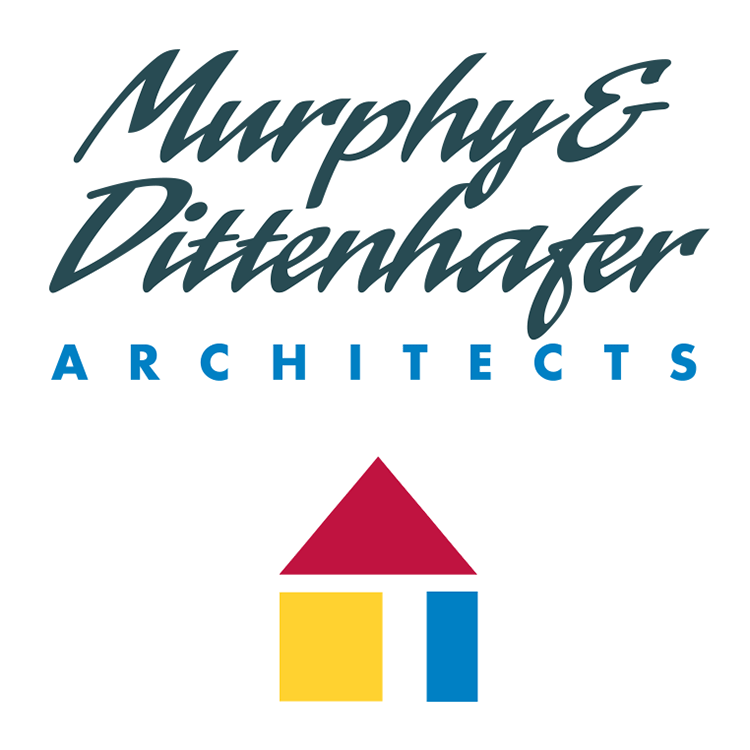Clients “bring the knowledge and understanding of their community, and we bring the knowledge of design married with purpose and inspiration,” says Architect Jonathan Taube.
Penn State York’s The Graham Center for Innovation and Collaboration
Frank Dittenhafer trekked across the Penn State York campus. He didn’t know what he was looking for, but he kept asking himself, “What else and what if…?”
This process – the search for more – is just part of design, says Dittenhafer, FAIA, LEED AP, President at Murphy & Dittenhafer Architects.
He considers a design, then flips things around to “the opposite.” It’s often in those moments when he steps back that the pieces fall together.
That’s what happened that day on the Penn State York campus.
When Penn State officials called on Murphy & Dittenhafer Architects to design The Graham Center for Innovation and Collaboration, there was already a previously considered site location in mind. But it took Dittenhafer asking the “why here?” question to open the possibilities for something better.
Walking the campus, Dittenhafer, and M&D Architect Todd Grove along with Penn State University representatives honed in on what Dittenhafer calls a “premier site” – the hilltop between the Pullo Performing Arts Center/Glatfelter Library and the Romano Main Classroom building – with a panoramic view of York.
“It was never part of the original plan for the building to end up there, and we had to significantly reconfigure the program of spaces because of the slopping hill,” he says. “In the end, it was the better choice – the right choice – and it took us exploring our options to find it.”









Dream big, then dream bigger
The process of design at Murphy & Dittenhafer Architects goes beyond just listening. Any technician can listen to a client’s problems related to their space and offer a solution that checks off the necessary boxes for codes, building issues, and sticking to a budget, says Dittenhafer.
“If you’ve communicated and worked creatively with your client to design an inspirational place that enriches the experience – a place where people would like to spend time – that’s Architecture,” he says.
One of Dittenhafer’s favorite things to hear is a client say, “We don’t know what to do. That’s why we hired you.”
Like us on Facebook!
That trust in M&D’s work opens the door for the creative process to unfold. While the goal for some firms may be to get to the finish line as quickly as possible, Dittenhafer says, the philosophy he instills is one that considers numerous scenarios.
“The nature of our design process is to be very comprehensive and explore all the possibilities to ensure we have the most inspired, most exciting approach that meets all the givens, as well,” Dittenhafer says.
Uncovering inspiration
The mission to dream big can be felt throughout Murphy & Dittenhafer Architects.
Architect Jonathan Taube took that to heart when he logged into a Zoom meeting with more than 30 community members voicing their ideas on what should be done to leave an impression at the Severn Intergenerational Center in Anne Arundel County, Maryland.
This meeting was an important one. It was the first time members of the community were seeing overall plans for the new 27,000-square-foot facility that will be home to a Boys and Girls Club, as well as a senior center with a regulation size gymnasium, food pantry, and classrooms.
It was also an opportunity for those community members to weigh in on an important goal for the center: how it could play a role in the overall community experience.





Bringing it all together
It’s the image of outstretched hands reaching for one another that inspired the plaza design for the Severn Intergenerational Center. The white canopy outside the main entrance is not just a welcoming image for those arriving to use the facility; it’s a place that invites the community to come together and to enjoy the outdoor space.
“We have a place here that is welcoming to people of all ages, from all backgrounds, working together to make their community a better place,” Taube says. “We found we could represent that ideal in the canopy design – in giving the community this common space in the plaza.”
There’s also the possibility of mosaic designs and community art, and while they may not fit the original budget and scope for the building project, Taube says, they’re exploring grant opportunities focused on enriching art experiences in Maryland.
“If people don’t appreciate or love their buildings, if they don’t see themselves in it, it becomes a building without meaning,” Taube says. “They bring the knowledge and understanding of their community, and we bring the knowledge of design married with purpose and inspiration. You need those things working together to create beautiful architecture.”
































Harford Community College’s expanded new construction Chesapeake Welcome Center is a lesson in Architectural identity